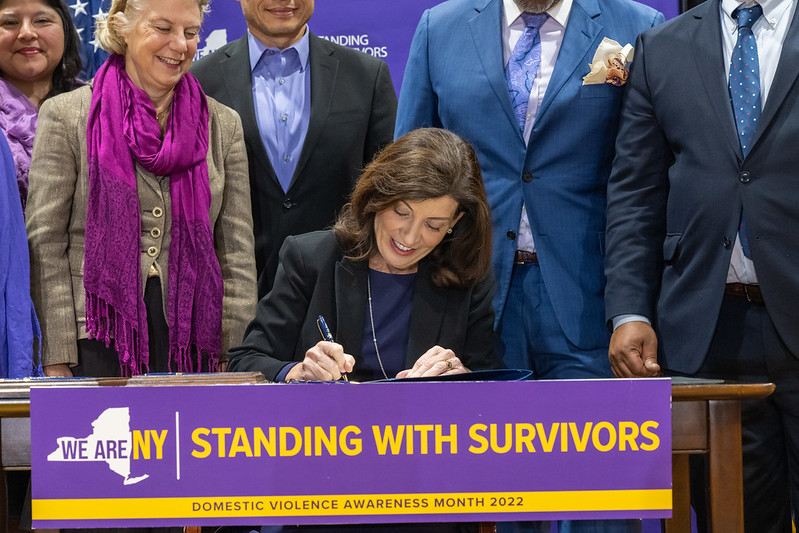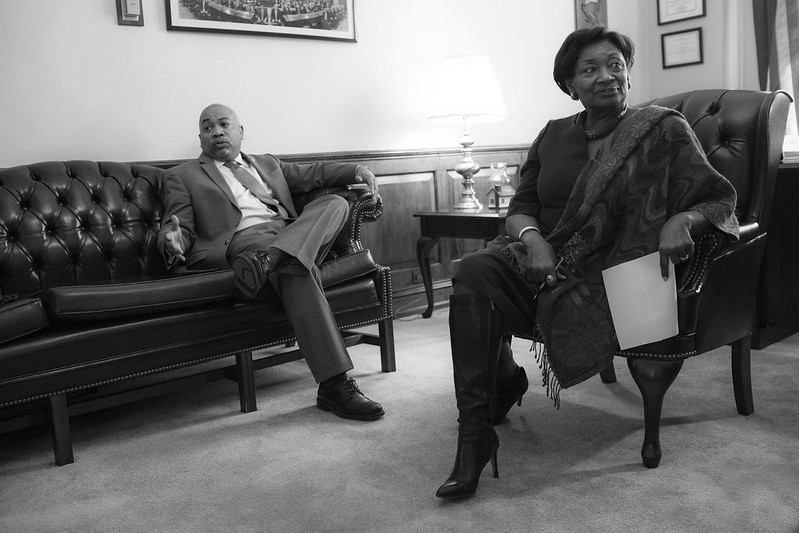Criminalized Survivors Deserve Sentencing Reform

Gov. Hochul signs legislation (photo: Darren McGee/Governor's Office)
Although it might sound counterintuitive to some, sentencing reform is necessary to effectively address intimate partner violence and support victims.
To start with, sentencing reform benefits criminalized survivors, victims of violence convicted of crimes related to their own victimization. Sometimes the victims of these crimes are their abusive partners; sometimes the crimes are committed at the behest of, or under duress from, their abusive partners.
Mandatory-minimum sentences are partly to blame for the substantial number of survivors who choose to plead guilty rather than face trial. Confronting the possibility of long terms in prison and “trial penalties” assessed for failing to plead guilty if they are convicted, women take pleas even in cases where they might have credible defenses. They take pleas so that they can get home to their children sooner, to protect their children from having to testify, and because they think they will not be believed.
The Domestic Violence Survivors’ Justice Act (DVSJA), passed in 2019, provides some relief from harsh mandatory minimums and creates a mechanism for reconsidering draconian sentences in some cases. But the DVSJA does not reach all of New York’s criminalized survivors.
For example, in November 2020, a 48-year-old woman who filed a DVSJA application was denied relief despite an extensive history of documented abuse from infancy through early adulthood and despite the fact that her abusive partner (who was the person harmed in the offense) supported her release. The court found she wasn’t a victim of domestic violence “at the time of the offense” (a criterion that must be met to qualify for relief) because it didn’t recognize the psychological abuse by her partner or the cumulative effects of childhood trauma. Since her incarceration she has come to better understand how trauma has affected her life and helps women on the inside grapple with the same issues she’s had to overcome. She is now entering her seventh year of a 16-year sentence.
Cases like this demonstrate why criminalized survivors are calling for sentencing reform, particularly the passage of the Eliminate Mandatory Minimums Act and Second Look Act, both under consideration by the New York State Legislature.
The Eliminate Mandatory Minimums Act would allow judges to consider mitigating circumstances - like abuse and trauma - rather than requiring them to impose a lengthy prison sentence regardless of circumstances. The Second Look Act would allow judges to review and reconsider excessive sentences. Right now, there is no mechanism outside of the DVSJA in New York State to reassess those sentences.
As a law professor who directs a Gender Violence Clinic providing direct representation to incarcerated survivors of intimate partner violence, sexual assault, and trafficking, it is abundantly clear to me that we have spent decades pursuing the wrong solutions to gender-based violence.
There is no evidence that harsh criminal sanctions like lengthy periods of incarceration or mandatory minimum sentences, which require judges to impose specific sentences for particular crimes without enabling them to use discretion in individual cases, decrease or deter intimate partner violence. But there is reason to believe that such sanctions make future violence more likely.
Intimate partner violence is highly correlated with economic hardship. Male under- and un-employment is strongly associated with perpetration of intimate partner violence (and with domestic violence homicides), as is experiencing other economic stress. People with criminal records, especially those who have spent years or decades in prison, have more difficulty finding and keeping work, are often employed in jobs with high turnover and little potential for growth, and earn less than people who have not been criminalized. They frequently live in economically distressed areas, and living in such neighborhoods is also correlated with higher rates of intimate partner violence.
Criminalization also causes trauma. It’s ironic that people who are being punished for violence are sent to places where they are likely to be victims of or witnesses to violence. There are few resources to help incarcerated people recognize and process the trauma that they have experienced, both before and during their incarceration. As a result, when they are released, formerly-incarcerated people take that unprocessed trauma with them back into their communities and their intimate relationships. That trauma can lead to post-traumatic stress disorder, which is highly correlated with the perpetration of intimate partner violence.
Prisons aren’t the way to end intimate partner violence. Yet we continue to pour resources into the criminal legal system, hoping, despite the best available evidence, that somehow incarceration will lead to positive outcomes for people who use violence and for their partners. And we do that despite the knowledge that not only is incarceration not working, but that it is harming those it was meant to protect.
We need to invest in the things that might end violence rather than continuing to throw money at prisons, even “gender responsive, trauma informed” prisons. We need to redirect the billions of dollars that currently go to the criminal legal system into economic stimulus, public health prevention, and communities. And we need to get people out of prison and back into communities, where they can heal, work, parent, and thrive. Yes, even for intimate partner violence, communities not cages is the right policy choice.
***
Leigh Goodmark is a law professor at the University of Maryland where she co-directs the Clinical Law Program, teaches Family Law, Gender and the Law, and Gender Violence and the Law, and directs the Gender Violence Clinic, a clinic providing direct representation in matters involving intimate partner abuse, sexual assault, trafficking, and other forms of gender violence. On Twitter @LeighGoodmark.
***
Have an op-ed idea or submission for Gotham Gazette? Email This email address is being protected from spambots. You need JavaScript enabled to view it.
Don't Believe the Hype; Bail Reform is Good Policy and Good Politics

Speaker Heastie & Majority Leader Stewart-Cousins (photo: State Senate)
In 2019, Democrats in New York were feeling pretty good. New York City had its first two-term Democratic mayor since the 1980s. Democrats controlled the Governor’s mansion in Albany and every other statewide office. We controlled the State Assembly and the State Senate – both with commanding majorities.
Washington, of course, was a mess. One party was in the thrall of a former game show host, and they were too afraid of upsetting him to get anything done. Say what you will about New York’s one-party rule. But here, at least, there was a real opportunity to make progress for people in need.
So that year, Democrats in Albany took a big swing. They finally reformed the cash bail laws that had, for decades, made a mockery of our criminal justice system and didn't make us any safer. Prior to these reforms, many New Yorkers accused of low-level crimes ostensibly had two options. They could sit in jail while they waited for their day in court, unable to work or prepare their defense. Or they could buy their way out.
But those options were only available to people with money. The ones who could afford to pay up of course did so. But many couldn’t – and so a disastrous, two-tiered criminal justice system took hold: one for the rich, and another for the poor. No New Yorker was any safer for rich people buying their way out, or poor people languishing in jail.
The reforms took away cash bail for low-level offenses, while maintaining it for alleged very serious or violent ones. They reunited countless New Yorkers with their families. They kept people who hadn’t been convicted of anything out of Rikers Island and other hellish jails. They finally made an unfair, racist system a little fairer.
And then the storm came.
I’m a longtime political consultant in New York, and I’ve never seen anything like it. Republicans and their media allies responded with manufactured rage from even before the law was changed and never stopped. They ignored the practicality of the reforms, which kept those accused of the most violent crimes in jail and leveled the playing field for everyone else. Every crime committed anywhere, by anyone, was suddenly a direct result of bail reform. They spent millions of dollars running bail-related attack ads before the 2020 elections — an attempt to terrify New Yorkers and benefit from a national crime spike.
Republicans told anyone who’d listen that voters would punish Democrats for their overreach and take away their 40-seat majority in the State Senate.
When the dust settled that November, Democrats had won 42 seats in the 63-seat Senate. The majority became a supermajority.
Maybe New York Republicans quietly blamed their failed, unpopular president. But they might have had a clue what voters were really experiencing if they had looked at the data. Bail reform was working. Study after study found no correlation between bail reform and any increase in crime. The New York Post examined NYPD data on gun violence and found that less than 1% of the 11,000 people released from jail in early 2020, when bail reform first went into effect, were involved in a shooting. More recently, as Nassau County leaders falsely blamed any crime on bail reform, their own study found that few are re-arrested.
Instead of following the data, Republicans tripled down.
Lee Zeldin’s run for governor was the darkest campaign in recent memory. He talked about bail reform almost every day. And he had help; Republicans poured millions in campaign donations to groups supporting him.
With no game show host to drag them down, Republicans were even more confident this year. They were sure a red wave would crash on New York – one that would cut a gash in the Assembly and Senate majorities, and maybe even sweep Zeldin into the Governor’s mansion.
Once again, it didn’t happen. Democrats won 41 seats in the State Senate this year. With one race heading to a recount, it could be 42. The Assembly supermajority is as commanding as ever. And Lee Zeldin lost by hundreds of thousands of votes.
Here’s what that means: after three years of predictions that bail reform would sink those who passed it, the Democratic Party has gained representation in state government.
Crime, of course, is still an animating issue for voters across the state. And Republicans likely won tight races for the House of Representatives by exploiting it. Many of those races were winnable; it’s hard to escape the feeling that we should have done even better. But the House of Representatives didn’t pass bail reform. Democrats in the State Legislature did – and New Yorkers, in two straight elections, ignored a tsunami of persuasion to reward them for it.
Politics is a tough business. But one thing remains true: voters will support you for doing the right thing, no matter how much money is spent to convince them not to. New Yorkers have asked for solutions on public safety, not scare tactics. They’re ready to address what’s really driving crime. Ignoring the data gets us nowhere.
With next year’s legislative session around the corner, Democrats will have another chance to enact bold changes. There’s plenty left to do; our criminal legal system still targets people of color and the poor, and advocates are bursting with ingenious, practical solutions. Democrats in Albany should give those policies a fair hearing, and act decisively. The politics will work in their favor. Be brave.
***
Jason Ortiz is a Democratic political consultant and the co-founder of Moonshot Strategies. On Twitter @hotroddy95 & @MoonshotNYC.
***
Have an op-ed idea or submission for Gotham Gazette? Email This email address is being protected from spambots. You need JavaScript enabled to view it.
New York City’s Largest Group of Drivers is Being Left Out of the Electric Vehicle Conversation

Gov. Hochul drives an electric vehicle (photo: Governor's Office)
A recently-launched pilot offers Uber, Lyft, and other for-hire-vehicle drivers the opportunity to trade their gas-powered vehicle in for an electric Tesla. An experienced, high-earning Uber driver, Angelis, jumped at the opportunity – but within a week returned the Tesla for a traditional black SUV. He loved driving the car and said his customers raved about it. But as a resident of the Bronx, it was not feasible for him to keep it — going electric meant he had to drive 35 minutes twice a day to a charging station and wait there for a charger to open. Because he drives so much, he spent almost as much on charging as he would on gas. So Angelis will be back in a gas-powered SUV until New York is ready to support his transition to an electric vehicle.
The news is filled with exciting investments from Washington and Albany in New York City’s electric vehicle future, but this effort is inadvertently ignoring the most critical subset of drivers who can have the largest impact on our city’s environmental footprint. For-hire-vehicle (FHV) drivers, like those on the Uber and Lyft platforms, outnumber yellow cab drivers 8 to 1.
New York State received federal backing for 60,000 new highway chargers, as well as an expanded supercharger network in Manhattan or near the city’s airports. This approach is geared towards leisure and commuting drivers, leaving FHV drivers in the dust.
FHVs have become a central part of the city’s transportation system. Among other benefits, FHVs supplement public transportation systems in the outer boroughs where buses and trains run less frequently or not at all. Certainly, the last thing New York City needs is more vehicles on the road — encouraging leisure or personal-use electric vehicles and charging support alone will only increase congestion.
As CEO of Voyager Global Mobility, the leading provider of for-hire vehicles in New York City, I work to support thousands of drivers, providing them with safe, up-to-date vehicles and support. I hear directly from drivers every day, and it has become clear that the key is to convert existing FHV-licensed vehicles to EVs rather than clogging our streets with new vehicles as Uber and Lyft aim to achieve their EV commitments.
There are 90,000 FHV licenses operating in the five boroughs of New York City, providing in sum an average of 600,000 rides a day. Luckily, New York is the most regulated city for the for-hire-vehicle industry in the world, which means drivers pass more rigorous screening, vehicles are inspected more often, and overall, FHVs are safe and reliable. Due to these extremely high standards and the continued need for professional drivers, many of these 90,000 New Yorkers have turned driving into a career, and their cars are their keys to a steady income and a foothold on the economic ladder.
The overwhelming majority of FHV drivers use gas-powered cars — only about 615 FHVs in all of New York City are EVs. It’s not that the mobility industry doesn’t care about the environment or resists EVs. The challenge is that the charging system does not support an equitable EV transition for drivers.
We cannot expect these hard-working New Yorkers to trade in their current vehicles — their most important revenue-generating asset — for EVs that will require inconvenient and expensive charging. They cannot waste time that could be used to make money to drive across the boroughs or along the highway to wait in long lines for a full charge (which already takes 40 minutes on its own).
Despite being home to 40% of New York City’s FHV drivers, Queens has just 16% of the city’s chargers. Manhattan is home to just 8% of New York’s TLC-licensed drivers, but the disproportionate concentration of chargers there primarily benefit residents that own individual electric vehicles, not the working-class drivers of the outer boroughs who rely on this infrastructure for their livelihoods.
New EV charging stations need to be concentrated in the outer boroughs, where FHV drivers actually live. FHV electric vehicles have to charge three times more frequently than personal cars, which are used much less frequently for fewer miles at a time.
As it stands, the city’s public charging network is tight and poorly distributed throughout the five boroughs. The entire city has roughly 2,000 public chargers (of which only about 120 are fast charging) for its nearly 6,000 EVs on the road, and 56% of those chargers are concentrated in Manhattan. Vehicle subscription companies, like Voyager Global Mobility, can pinpoint exactly which neighborhoods have high numbers of drivers. There are certain zip codes in Queens with 100+ clients renting for-hire-vehicles just from us — those are the areas where we need to focus our expanded EV charging infrastructure efforts.
Further, we need to ensure that charging is affordable outside of the congested areas of Manhattan. Recently, the TLC announced discounts at NYC Department of Transportation charging hubs, which is extremely helpful. However, it only covers two hubs, neither of which are in the Bronx or Brooklyn.
We need to acknowledge that this city is not set up for anywhere close to 90,000 gasoline cars to be converted to EVs. If not now, when? EV investments must focus on the needs of FHV drivers. We’re ready for solutions and we invite the city, the state, and other partners to come along for the ride.
***
Sam Jurkowicz is a former Uber driver and the CEO of Voyager Global Mobility, the leading provider of vehicles and services for NYC’s growing for-hire-vehicle mobility needs.
***
Have an op-ed idea or submission for Gotham Gazette? Email This email address is being protected from spambots. You need JavaScript enabled to view it.




